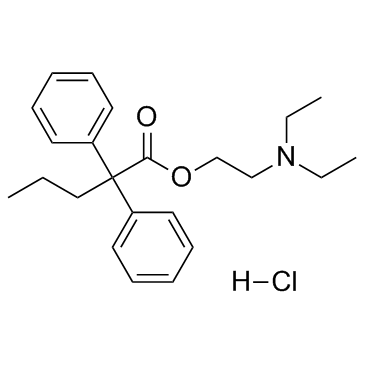Proadifen hydrochloride

Proadifen hydrochloride structure
|
Common Name | Proadifen hydrochloride | ||
|---|---|---|---|---|
| CAS Number | 62-68-0 | Molecular Weight | 389.959 | |
| Density | N/A | Boiling Point | 460.8ºC at 760 mmHg | |
| Molecular Formula | C23H32ClNO2 | Melting Point | 122-123ºC | |
| MSDS | Chinese USA | Flash Point | 132.3ºC | |
|
Effects of cytochrome P450 inhibitors on peroxidase activity.
Neuro Endocrinol. Lett. 33 Suppl 3 , 33-40, (2012) Of several enzymes metabolizing xenobiotics, cytochrome P450 (CYP) and peroxidase enzymes seem to be most important. One of the major challenges in studies investigating metabolism of xenobiotics is to resolve which of these two groups of enzymes is predomina... |
|
|
Methamphetamine accelerates cellular senescence through stimulation of de novo ceramide biosynthesis.
PLoS ONE 10(2) , e0116961, (2015) Methamphetamine is a highly addictive psychostimulant that causes profound damage to the brain and other body organs. Post mortem studies of human tissues have linked the use of this drug to diseases associated with aging, such as coronary atherosclerosis and... |
|
|
Subepithelial trypsin induces enteric nerve-mediated anion secretion by activating proteinase-activated receptor 1 in the mouse cecum.
J. Physiol. Sci. 62(3) , 211-9, (2012) Serine proteases are versatile signaling molecules and often exert this function by activating the proteinase-activated receptors (PAR(1)-PAR(4)). Our previous study on the mouse cecum has shown that the PAR(1)-activating peptide (AP) and PAR(2)-AP both induc... |
|
|
Methyl palmitate: a potent vasodilator released in the retina.
Invest. Ophthalmol. Vis. Sci. 51(9) , 4746-53, (2010) To determine whether palmitic acid methyl ester (PAME) or methyl palmitate is the retina-derived relaxing factor (RRF).A superfusion bioassay cascade technique was used with rat isolated retina as donor tissue and rat aortic ring as detector tissue. The super... |
|
|
Hepatic cytochrome P450s attenuate the cytotoxicity induced by leflunomide and its active metabolite A77 1726 in primary cultured rat hepatocytes.
Toxicol. Sci. 122(2) , 579-86, (2011) The Black Box Warning section of the U.S. drug label for leflunomide was recently updated to include stronger warnings about potential hepatotoxicity from this novel anti-arthritis drug. Because metabolic activation is a key mechanism for drug-induced hepatot... |
|
|
In vitro inhibition of breast cancer spheroid-induced lymphendothelial defects resembling intravasation into the lymphatic vasculature by acetohexamide, isoxsuprine, nifedipin and proadifen.
Br. J. Cancer 108(3) , 570-8, (2013) As metastasis is the prime cause of death from malignancies, there is vibrant interest to discover options for the management of the different mechanistic steps of tumour spreading. Some approved pharmaceuticals exhibit activities against diseases they have n... |
|
|
Effects of cytochrome P450 inducers and inhibitors on the pharmacokinetics of intravenous furosemide in rats: involvement of CYP2C11, 2E1, 3A1 and 3A2 in furosemide metabolism.
J. Pharm. Pharmacol. 61(1) , 47-54, (2009) It has been reported that the non-renal clearance of furosemide was significantly faster in rats pretreated with phenobarbital but was not altered in rats pretreated with 3-methylcholanthrene. However, no studies on other cytochrome P450 (CYP) isozymes have y... |
|
|
Adrenic acid metabolites as endogenous endothelium-derived and zona glomerulosa-derived hyperpolarizing factors.
Hypertension 55(2) , 547-54, (2010) Adrenic acid (docosatetraenoic acid), an abundant fatty acid in the adrenal gland, is identical to arachidonic acid except for 2 additional carbons on the carboxyl end. Adrenic acid is metabolized by cyclooxygenases, cytochrome P450s, and lipoxygenases; howev... |
|
|
Role of metabolism in 1-bromopropane-induced hepatotoxicity in mice.
J. Toxicol. Environ. Health A 73(21-22) , 1431-40, (2010) A possible role of metabolism in 1-bromopropane (1-BP)-induced hepatotoxicity was investigated in male ICR mice. The depletion of glutathione (GSH) by formation of GSH conjugates was associated with increased hepatotoxicity in 1-BP-treated mice. The formation... |
|
|
Cancer prevention mediated by caffeic acid phenethyl ester involves cyp2b1/2 modulation in hepatocarcinogenesis.
Toxicol. Pathol. 40(3) , 466-72, (2012) Studies of cancer chemoprevention with caffeic acid phenethyl ester (CAPE) in the resistant hepatocyte model of hepatocarcinogenesis have shown the participation of CYP drug metabolizing enzymes. To prevent neoplastic and preneoplasic lesions, we must specifi... |